In the 1970’s and 1980’s, when he turned his hand to lithographs and serigraphs, he became widely known in the United States. As the Art Deco style came back into fashion, many of his works, including ”The Alphabet” and ”The Numbers” series, were sold as posters. Erte ( 1892-1990 ) was attracted to the theater and at one point wavered between becoming a dancer or an artist. But eventually, he recalled years later, ”I came to the conclusion that I could live without dancing but could not give up my passion for painting and design.”

Erte's "improvised cage" was on the cover of Harper's Bazaar in July, 1922. later that year, the design turned up as a costume, right, for the Greenwich Village Follies.
In 1912, he moved to Paris and collaborated briefly with the fashion designer Paul Poiret. Moving on to the theater, he designed costumes for an exotic young dancer named Mata Hari, who would be shot as a spy for the Germans in 1917. Performers from Sarah Bernhardt to Anna Pavlova would wear his costumes.
Between 1915 and 1937 he designed hundreds of covers for the monthly fashion magazine Harper’s Bazaar. His highly stylized designs of sinuous women draped in beads and furs helped define fashion for a generation.More than any other designer, Erté brought the decadent style and rich colors–jade green, crimson, and orange–of the Orient to life for Westerners. Influenced by everything from Greek vase paintings to Egyptian idols, Indian iconography and Russian religious art, Erté’s designs embraced the exotic; they often seemed straight out of Arabian Nights.
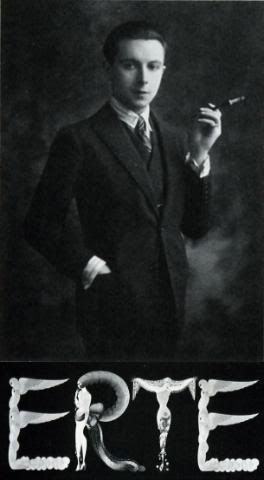
Portrait, 1924 The Russian-born painter Romain de Tirtoff, who called himself Erté after the French pronunciation of his initials, was one of the foremost fashion and stage designers of the early twentieth century. From the sensational silver lamé costume, complete with pearl wings and ebony-plumed cap, that he wore to a ball in 1914, to his magical and elegant designs for the Broadway musical Stardust in 1988, Erté pursued his chosen career with unflagging zest and creativity for almost 80 years. On his death in 1990, he was hailed as the "prince of the music hall" and "a mirror of fashion for 75 years".
Exquisitely detailed and precise, his drawings are playfully erotic, emphasizing luxury, beauty, and spectacle. The women in his drawings may be scantily clad, but the somewhat androgynous female form is beautified and celebrated rather than exploited.
When male figures are incorporated into his design, they are nearly always homoerotic. His designs were so popular and imaginative that Erté was given space in Harper’s Bazaar to describe his scenes in quaint Wildean tales. His work would also appear in Vogue, the Illustrated London News, Cosmopolitan and Ladies’ Home Journal.
Whether fashioning an alphabet or a stageful of lavish costumes, Erté was a great purveyor of elegance in the twenties and thirties. One need not claim too much for Erté in order to appreciate his exquisitely executed designs. They are not only wonderfully imaginative but great fun to look at. His theatre costumes recall exotic Oriental forms. As the artist Georges Barbier noted in 1929, “One has to examine the bas-reliefs of Angkor, the paintings of Benares, to find these four tiered diadems, these girdles entwined like stalks in flower, these sleeves that are so heavy that the slaves must make an effort to support them, and these trains, studded with eyes like the tail of a peacock, which, when unfurled, fill the range of vision like a rainbow stretching to the sky.”
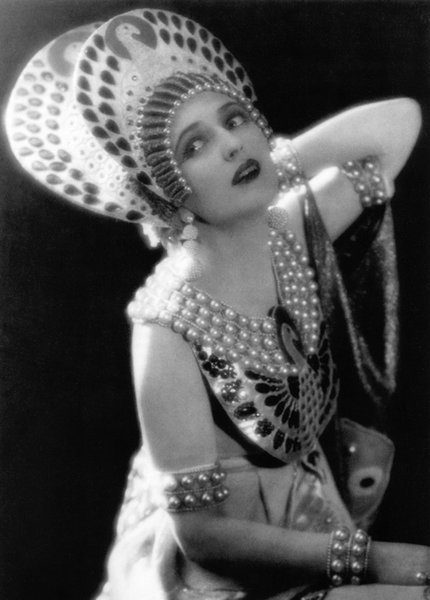
Erte's first break into American fashion society was with his cover designs for the chic journal Harper's Bazaar as a fashion illustrator. Erte contributed his drawing to the journal for 22 years. (Things I Remember 25) Referring to covers for Harper's Bazaar, White states, "They shaped the entire modern tradition of fashion drawing." (qtd. in Spencer 47) His first cover for the magazine was published January 1, 1915.
In his fashion collections, there were no discreet little black dresses. That was hardly Erté’s style. Instread there are opulent silk pyjama suits, coats of fur trimmed velvet, and slinky gowns dripping with beads, fringes and tassels. In Erté’s world, fantasy reigns.
Born Romain de Tirtoff, Erté was the only son of an admiral of the Russian Imperial Navy. His family was a part of the social elite of St. Petersburg, a glittering capital of prerevolutionary culture and the most French of all Russian cities. The Tirtoff’s turned out regularly for the opera, the ballet, museum exhibitions, and the fashion shows of the latest French designers. Young Erté was fascinated. His mother, who loved elegant clothes, encouraged his early artistic efforts, and once, when he was five, ordered from her dressmaker a gown he had designed. When, however, at the age of nineteen he declared his intention of going to paris to become a designer, his family blanched; architecture was urged as a more suitable career. In 1912 he did finally set off f
aris, but only after having made a solemn promise to enroll at the Ecole des Beaux Arts.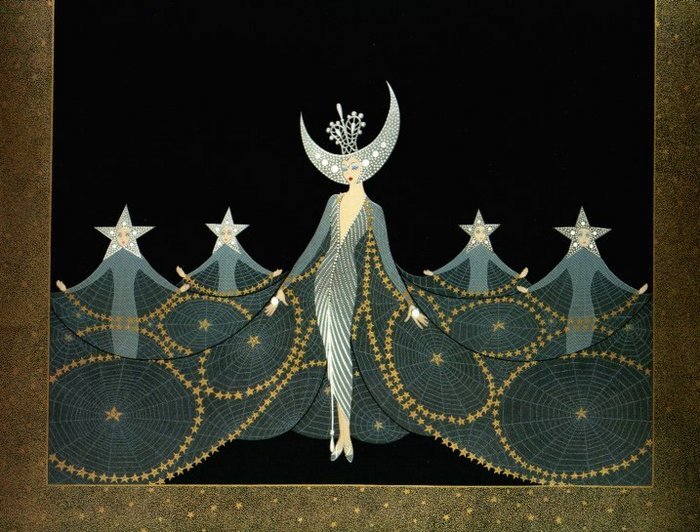
"Erte worked fearlessly, and he was blessed with strength and confidence and intuition. While the theatre world was long a haven for the queer, the early 1900s weren’t exactly an ideal era to burst out of the closet in. Will and Grace had not yet brought camp into everybody’s normal social circle. Madonna had not yet rolled out the red carpet. Furthermore, Erte was the only son of a Russian Imperial Fleet admiral. Still, his gayness must have been obvious even to those who had never known or heard of such a thing. Even as a child, Erte looked effeminate. He wanted to be a ballerina! He hated war passionately, unlike all the men in his bloodline who lived for their military duties. Erte had beauty, not violence, in his heart."
Romain de Tirtoff was neither the first nor the last young visitor to Paris to ignore his parents’ wishes. He got an education, not at the Ecole des Beaux Arts, but in the museums, at the galleries that showed the fauves and the cubists, at performances of Sergei Diaghilev’s Ballets Russes, and in racy music halls. A careful observer of the fashion parade on the Paris streets, he began to send drawings home to a Russian fashion magazine. To keep his career from embarrassing his parents, he used various pseudonyms, finally settling on Erté, the French pronunciation of his initials.

Ann Pennington rehearses a dance step, the Black Bottom, for George White's Scandals of 1925. For wHITE'S mANHATTAN mARY, 1927, Erté created a black bottom costume at right.
The high priest of Paris fashion at that time was the designer Paul Poiret, whose Oriental styles were all the rage. Harem pants, in the form of Poiret’s “jupe culotte”, his gauzy tunics with voluminous sleeves, and his sultry perfumes wafted through elegant salons. Erté had long idolized Poiret. At the end of 1912, without much hope for success, he sent some drawings to the Poiret establishment, and was hired as one of two full-time designers. That same year, the “Gazette du Bon Ton” , the city’s leading fashion magazine, published two Erté hat designs, and his first costumes for the theatre appeared onstage, one of them, an Oriental concoction of harem pants and sashes, worn by none other than Mata Hari. For a young man not twenty-one it was an extraordinary beginning.

Among the designs that Erté produced for the Metro-Goldwyn Mayer studios in 1929 was the velvet and ermine gown at left. It is worn by Eileen Pringle, right, in The Mystic.
Poiret’s shop closed at the outbrak of World War I, but by then it hardly mattered to Erté, for he was well on his way. By the mid-twenties his clothes were not only in exclusive shops in Paris but in Altman’s and Bendel’s in New York, and his drawings and cover designs were being published regularly by Harper’s Bazaar. So were his comments on fashions and the social scene. He confessed to his readers that he loved decking himself out in costumes, and once he reported that he went to a ball at the Monte Carlo Sporting Club dressed as a mummy: “I was led through the room by an Egyptian slave,” he exulted. “The wrappings were then taken off by the slave and, freed from the golden cape wrapped around his body, I appeared in the costume of an Egyptian Pharaoh.” For ordinary daytime wear, Erté preferred mauve suits, and the privacy of his villa in Monte Carlo he wore ermine lounging pyjamas.
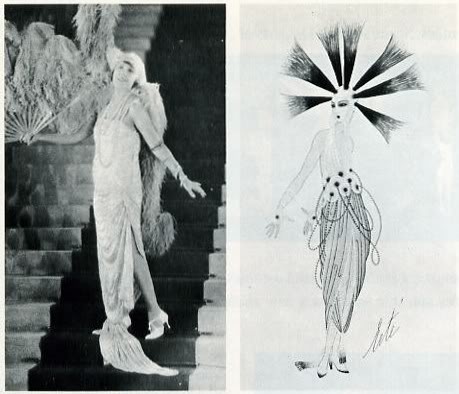
When ùerte began his career as a theatre designer, Mistinguett was the star of the French music hall. In 1917 she wore his costume, at right, in marvels of the Orient
“Indeed, he attributes indulgence and its moderation as the force behind his longevity- including the two, and only two, cigarettes per day that he enjoyed for most of his life. He also enjoyed dressing up- back in the early days, he referred to ‘drag’ as ‘in costume.’ A petite, elegant harlequin of a man, no one knew. Sometimes it wasn’t drag, per se, but such over-the-top outlandishness that his presence was unforgettable. Erte liked to intrigue his dinner companions by modeling various Asian robes, wearing a different one for every course served! But even when he dressed fashionably male, he was often mistaken for a woman.”
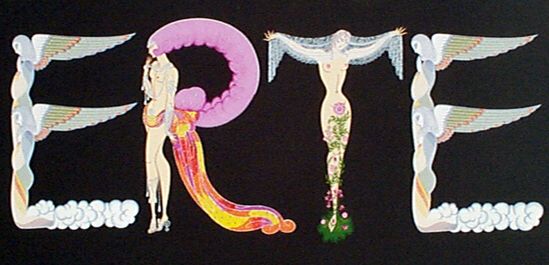
"His famed "Alphabet Suite" is at the Centre Pompidou Museum in Paris, and depicts each letter of the alphabet in true Erté style. Using the human form in various states of déshabillé, various poses and props are illustrated to create the letters of the alphabet. These artworks, which Erté began in 1927, were later printed as a suite of limited edition prints. The prints were an immediate success upon their release in 1977 and are now extremely rare as a complete set."
With his penchant for fantasy and display, Erté found his greatest pleasure in designing for the music hall stage. Toward the end of World War I, the paris music halls began producing revues that offered nearly nude women, elegant costumes and lavish sets. One pioneer of the genre was Madame Rasimi, director of the Ba-ta-Clan Theatre. In 1917, she staged a famous revue, “Marvels of the Orient”, for which Erté designed and costumed an entire act, “The Thousand and Second Night at Baghdad.” It featured, among other things, a “caliph’s favorite” who wore ropes of pearls around her breasts and harem pants slit seductively at the waist. The revue starred two of the biggest drawing cards on the music hall, Maurice Chevalier and Mistinguett. For the latter Erté created a series of gowns and huge feathered headdresses.
a





 COMMENTS
COMMENTS
Very interesting.
I am well known for my Erté exhibition in Rome (2001), which was labelled as the most beautiful exhibition of the year in Europe, and the most elegant event opened in Rome in 30 years’ time.It attracted visitors from all over the world and especially from the US.
The Italian version of a video (“Erté – Fascino e Seduzione Déco”) can be seen on YouTube.